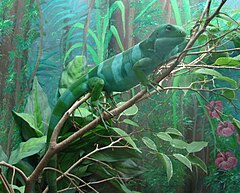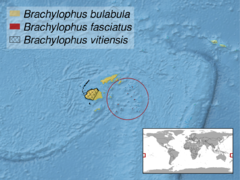Brachylophus
Wygląd
| Brachylophus | |||
| Cuvier, 1829[1] | |||
 Przedstawiciel rodzaju – legwan fidżyjski (B. fasciatus) | |||
| Systematyka | |||
| Domena | |||
|---|---|---|---|
| Królestwo | |||
| Typ | |||
| Podtyp | |||
| Gromada | |||
| Rząd | |||
| Podrząd | |||
| Rodzina | |||
| Rodzaj |
Brachylophus | ||
| Typ nomenklatoryczny | |||
|
Iguana fasciata Brongniart, 1800 | |||
| Synonimy | |||
|
| |||
| Gatunki | |||
| |||
| Zasięg występowania | |||

| |||
Brachylophus – rodzaj jaszczurek z rodziny legwanowatych (Iguanidae).
Zasięg występowania
[edytuj | edytuj kod]Rodzaj obejmuje gatunki występujące w stanie naturalnym na wyspach Fidżi w Oceanii; legwan fidżijski został introdukowany na Tonga[3][4].
Systematyka
[edytuj | edytuj kod]Etymologia
[edytuj | edytuj kod]- Brachylophus: gr. βραχυς brakhus „krótki”; λοφος lophos „grzebień, pióropusz”[5]; w aluzji do krótkich, kolczastych czubków umiejscowionych wzdłuż grzbietu tych zwierząt.
- Chloroscartes: gr. χλωρος khlōros „zielony”[6]; σκαρτης skartēs „skoczny, szybki, zwinny”, od σκαιρω skairō „skakać, tańczyć”[7]. Gatunek typowy: Chloroscartes fasciatus Günther, 1862 (= Iguana fasciata Brongniart, 1800).
Podział systematyczny
[edytuj | edytuj kod]Do rodzaju należą następujące występujące współcześnie gatunki[3]:
- Brachylophus bulabula Fisher, Harlow, Edwards & Keogh, 2008
- Brachylophus fasciatus (Brongniart, 1800) – legwan fidżyjski[8]
- Brachylophus gau Fisher, Niukula, Watling & Harlow, 2017
- Brachylophus vitiensis Gibbons, 1981 – legwan wityjski
Opisano także wymarły gatunek z późnego holocenu wyspy Foa należącej do Tonga[9]:
- Brachylophus gibbonsi Pregill & Steadman, 2004.
Przypisy
[edytuj | edytuj kod]- ↑ G. Cuvier: Le règne animal distribué d’après son organisation, pour servir de base à l’histoire naturelle des animaux et d’introduction à l’anatomie comparée. Wyd. 2. Cz. 2. Paris: Chez Déterville, 1829, s. 40. (fr.).
- ↑ A.C.L.G. Günther. Descriptions of New Species of Reptiles and Fishes in the Collection of the British Museum. „Proceedings of the Zoological Society of London”. 1862, s. 188, 1862. (ang.).
- ↑ a b P. Uetz & J. Hallermann: Genus: Brachylophus. The Reptile Database. [dostęp 2023-04-15]. (ang.).
- ↑ R. Midtgaard: Brachylophus. RepFocus. [dostęp 2023-04-15]. (ang.).
- ↑ brachylophus, [w:] The Key to Scientific Names, J.A. Jobling (red.), [w:] Birds of the World, S.M. Billerman et al. (red.), Cornell Lab of Ornithology, Ithaca [dostęp 2021-12-27] (ang.).
- ↑ Jaeger 1944 ↓, s. 49.
- ↑ Jaeger 1944 ↓, s. 205.
- ↑ Praca zbiorowa: Zwierzęta: encyklopedia ilustrowana. Warszawa: Wydawnictwo Naukowe PWN, 2005. ISBN 83-01-14344-4.
- ↑ G.K. Pregill & D.W. Steadman. South Pacific iguanas: human impacts and a new species. „Journal of Herpetology”. 38 (1), s. 17, 2004. JSTOR: 1566081. (ang.).
Bibliografia
[edytuj | edytuj kod]- D.E. Frost & R.E. Etheridge. A Phylogenetic Analysis and Taxonomy of Iguanian Lizards (Reptilia: Squamata). „University of Kansas Museum of Natural History Miscellaneous Publications”. 81, s. 1–65, 1989. (ang.).
- D.R. Frost, R.E. Etheridge, D. Janies & T.A. Titus. Total evidence, sequence alignment, evolution of Polychrotid lizards, and a reclassification of the Iguania (Squamata: Iguania). „American Museum Novitates”. 3343, s. 1–38, 2001. (ang.).
- R.N. Fisher, J. Niukula, D. Watling & P.S. Harlow. A new species of iguana Brachylophus Cuvier 1829 (Sauria: Iguania: Iguanidae) from Gau Island, Fiji Islands. „Zootaxa”. 4273 (3), s. 407–422, 2017. DOI: 10.11646/zootaxa.4273.3.5. (ang.).
Linki zewnętrzne
[edytuj | edytuj kod]- Zdjęcia B. bulabula. online.wr.usgs.gov. [zarchiwizowane z tego adresu (2008-09-23)].
- Edmund C. Jaeger, Source-book of biological names and terms, wyd. 1, Springfield: Charles C. Thomas, 1944, s. 1-256, OCLC 637083062 (ang.).
